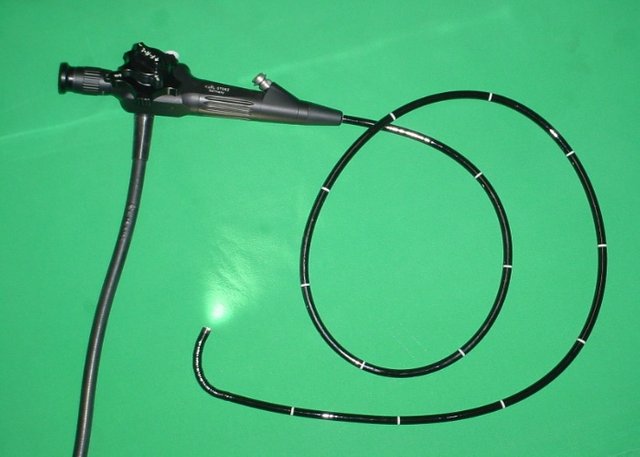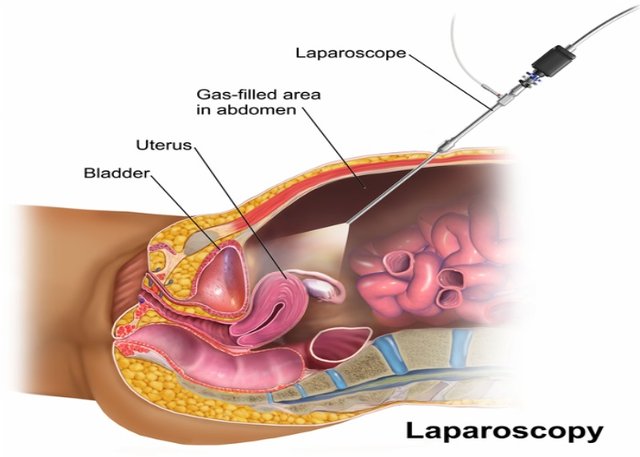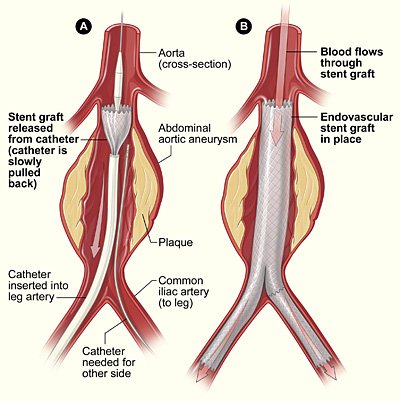Endoscopy And The Science Of Visualizing The Inaccessible Obscurity
Hey guys, don't be taken aback by the title of this piece. I bet in no much time, you gonna get the gist of what this is all about. Okay, with that said, let me take you a little back into history. Assuming you are a 19-century physician and a patient come running after you with a complaint of acute stomachache. I bet your first approach would be to prescribe some tablets for him and then monitor his response? Okay what if his response is not anything positive so that he continues to shout for help despite all your efforts to stabilize him?

[Flexible endoscope. Source: wikimedia commons. Author: d
Benutzer Kalumet. CC BY-SA 3.0 licensed]
I guess at this point, you would wish if there was any means you can look inside of his body to really find out what's going on there. At this point, there are two options left : it is either you subject him to hours of harrowing experience of crude invasive procedure or you continue to feed him with tablets and injections. I bet a good physician would have chosen the former but that would be too painful. Unfortunately back then, there was no way of taking a look inside of the patient's body without subjecting him to painful invasive process. But that's not anymore! Thanks to invention of imaging gadgets like endoscopes with which surgeons can now see inside of the body and perform corrective procedures without having to cut it open. In this article, we will be taking a closer look at how they work and what they are.
Explaining endoscope
An endoscope is a tool surgeons insert into the body cavities during an endoscopy to give a view of its internal parts and operate on them where necessary. It is somewhat like a bendy telescope medical professionals can adopt in order to view internal environment of a particular body cavity. It differs from telescope in that the part that's inserted into the body is relatively flexible and bendable to enable maneuverings within body cavities.
A typical endoscope is made of two or three major optical cables, with each of these major cables comprising about 50,000 optical fibres made from quality glass or plastic. Essentially, one or two of these cables convey light down to the the area of interest within a cavity while the other carries the reflected light (with vivid image of the patient's body) back to the physician's eyepiece or into a camera which now displays it on a TV monitor.

[Source: wikimedia commons. Author: BruceBlaus. CC BY 3.0 licensed]
There is a striking similarity between the optics of an endoscope and those found in a telescope. At one distal end is an objective lens linking one or more bendy sections of fiber-optic cable known as relays. These relays carry reflected light rays from the patient's body and focus them on a second lens within the eyepiece or to a monitor, which is adjustable to enable a brighter view much like eyepieces found on binoculars.
A glimpse into the history of endoscope
Though there were attempts to take a view of inside the body as back as 19th century but the earliest date of the patent on this was in 1911. By modern standards, first generation endoscopes were bulky, crude and place the light source inside the body during the probe of internal environment with risk of possibly burning or causing dry out of the internal tissues being examined by the heat emanating from the light source.
Much later in the early 1950s or thereabouts, Max Fourestier alongside his colleagues working at the Centre National de la Recherche Scientifique, Paris, France, used quartz or Plexiglas and developed an endoscope which for the first time aided the viewing of patient's internal body parts by directing light rays from a source outside the patient's body. This marked a major breakthrough and an important stepping stone for later development of fiber optic based endoscopes.
However, the development of basic technology on which modern endoscopes run was credited to English physicist and his Indian student named Narinder Kaplan. In early 1950s, both men engineered a way of making flexible pieces of glass which are now regarded as optical fibers (being the thicker version of today's fiber optic cables currently used in telecommunications). A collaborative project between three scientists (Basil Hirschowitz, Lawrence Curtiss, and C. Wilbur Peters) from University of Michigan, in mid-50s, led to development of gastroscope using optical-fiber technology. The gastroscope was initially used to examine patient's stomach but was later extended to studying other body cavities.
Endoscopes & minimally invasive procedures
These days, endoscopes come with much more capabilities than just being used to pip around within the body's cavities. They are increasingly being used to perform some corrective surgical operations and other minor procedures as well as to view internal cavities. By turning the knobs or pulling on the cables, dismal ends of endoscope can be moved about, swivel and can even be bent from side by side.

[Minimally invasive procedure — Aneurysm endovascular. Source: wikimedia commons. Author: National Institutes of Health. Public domain licensed]
A tiny forceps of the secondary tube which is attached to the main optical cable can be used to suck out obstructing fragments of matter ( e.g from blocked bronchial tubes) as well as performing biopsies (in which small tissue sample is cut out for testing). Surgeons use endoscopes to guide and focus powerful precision lasers to kill diseased tissues, heal wounds and even make accurate incision while viewing what they are doing using eyepiece or on TV monitor. This is called minimally invasive surgery which is very less traumatic than conventional surgical procedures. However, patients still have to be put on an anesthetic state, and there can also be complications as no medical procedure is 100% without a flaw.
Types of endoscopes
It should be noted that the term "endoscope" is a generic name for any tool used to view inside of body cavities. The below names are terms ascribed to particular forms of examination:
- Duodenoscope: for viewing inside of small intestine.
- Colonoscope: for viewing inside of colon and bowel.
- Esophagogastroduodenoscope: for viewing inside of Esophagus, small intestine and stomach.
- Cytoscope: for viewing inside of bladder.
- Arthroscope: for viewing inside of joints.
- Bronchoscope: for viewing inside of lungs and Esophagus.
- Coloposcope: for examining inside of vagina and cervix.
- Cystoeurethroscope: for examining inside of urethra and bladder.
- Laryngoscope: for viewing inside of larynx
- Gastroscope: for viewing inside of stomach.
- Hysteroscope: for viewing the womb.
- Fetoscope: for viewing inside of womb.
- Laparocope: for viewing inside of abdomen
- Ureteroscope: for viewing pelvis and ureter.
- Peritoneoscope: for viewing inside of Peritoneum.
- Thoracoscope: for viewing inside of Thorax.
- Proctosigmoidoscope: for lower part of the large intestine.
- Sigmoidoscope: for viewing large intestine.
Uses of endoscopes are not only limited to medical diagnosis and performing surgeries, their applications extend to inspecting inaccessible areas of buildings as well as parts of machines that is not easily accessible for people. When endoscopes are used industrially in this way, they are called borescopes and fiberscopes. Thanks for reading.
References
- Endoscopy: an overview
- Endoscopy: medical procedure
- Digestive disease and endoscopy
- Endoscopes
- Minimally invasive procedures
- Endoscopy
- Endoscopy
Truly yours,
@sciencetech
STEM contributor
Hello @sciencetech :)
I like how you manage to keep your posts concise! I was most drawn to the part you covered the history of endoscopes here. It always fascinates me to learn the processes we have gone through to get to the point we are. Especially in the field of health. I have the impression that the 50's was a great decade; one that also marked the arrival of anti-psychotic drugs, for example :)
All the best to you :D
I'm impressed with what he dug up too.
Thanks sir for appreciating my effort
Thanks very much for the nice words. I see your highly loaded with knowledge.
@sciencetech
i am following you and voting you please follow and vote me back
This post has been voted on by the steemstem curation team and voting trail.
There is more to SteemSTEM than just writing posts, check here for some more tips on being a community member. You can also join our discord here to get to know the rest of the community!
Hi @sciencetech!
Your post was upvoted by utopian.io in cooperation with steemstem - supporting knowledge, innovation and technological advancement on the Steem Blockchain.
Contribute to Open Source with utopian.io
Learn how to contribute on our website and join the new open source economy.
Want to chat? Join the Utopian Community on Discord https://discord.gg/h52nFrV